In this part of this guide I will get into the last variables and insights of the baking process that directly affects the visual outcome on your country style sourdough loaf. In the first part I focused on the why and the preparations leading up to THE moment. These preparations are what will affect 90% of the outcome so check it out if you haven’t. Let’s get started on the finishing touches of a process that potentially have stretched of several days.
Now before we break this down further you need to know what happens when you put well-balanced dough on a really hot surface, inside a really hot oven. During the fermentation gas pockets have formed inside the dough. These pockets have a different amount of gas depending on the flours capacity, the sourdoughs effect and how you’ve handled it during the process. When heat is applied the gas expands upwards, looking to exit the bread. The water in the dough also begins to expand and vaporize (becoming gas, pushing upwards). The gas will look for the path of least resistance. If you don’t score at all it will create cracks where the dough is at its weakest. If you do less cuts the gas will expand towards less surface and the uprising effect on the settling crust will be grater. More cuts spreads the effect.
The last variables
- The determination and confidence in THE moment
- The friction (swiftness)
- The force, depth and angle
- The added flour for contrasts
- The heat, steam and timings during the bake
The determination and confidence in THE moment
Yes, it’s THE moment. That half nervous half excited trembling moment where a perfectly shaped, naked piece of dough lies before you. You need a plan to get you focused on the task. Before your loaf left the basket and before the blade touches its skin you need to have a well thought out plan, which you are determined to stick with. By the time my son started to explore crayons a year ago I started to explore scoring patterns. I often spent a good time stenciling out a loaf and practice the lines while my boy spent his time by destroying it.
Try out how the esthetics feels to you by drawing the pattern on a piece of paper and think through in what directions you plan to strike the cuts. How to flour the surface. Believe me, it makes a big difference in the end. Also, take the variables presented in the last article in mind when planning your move (under, over, strong and weak dough).
Enter THE moment with confidence and a plan to take joy from it.
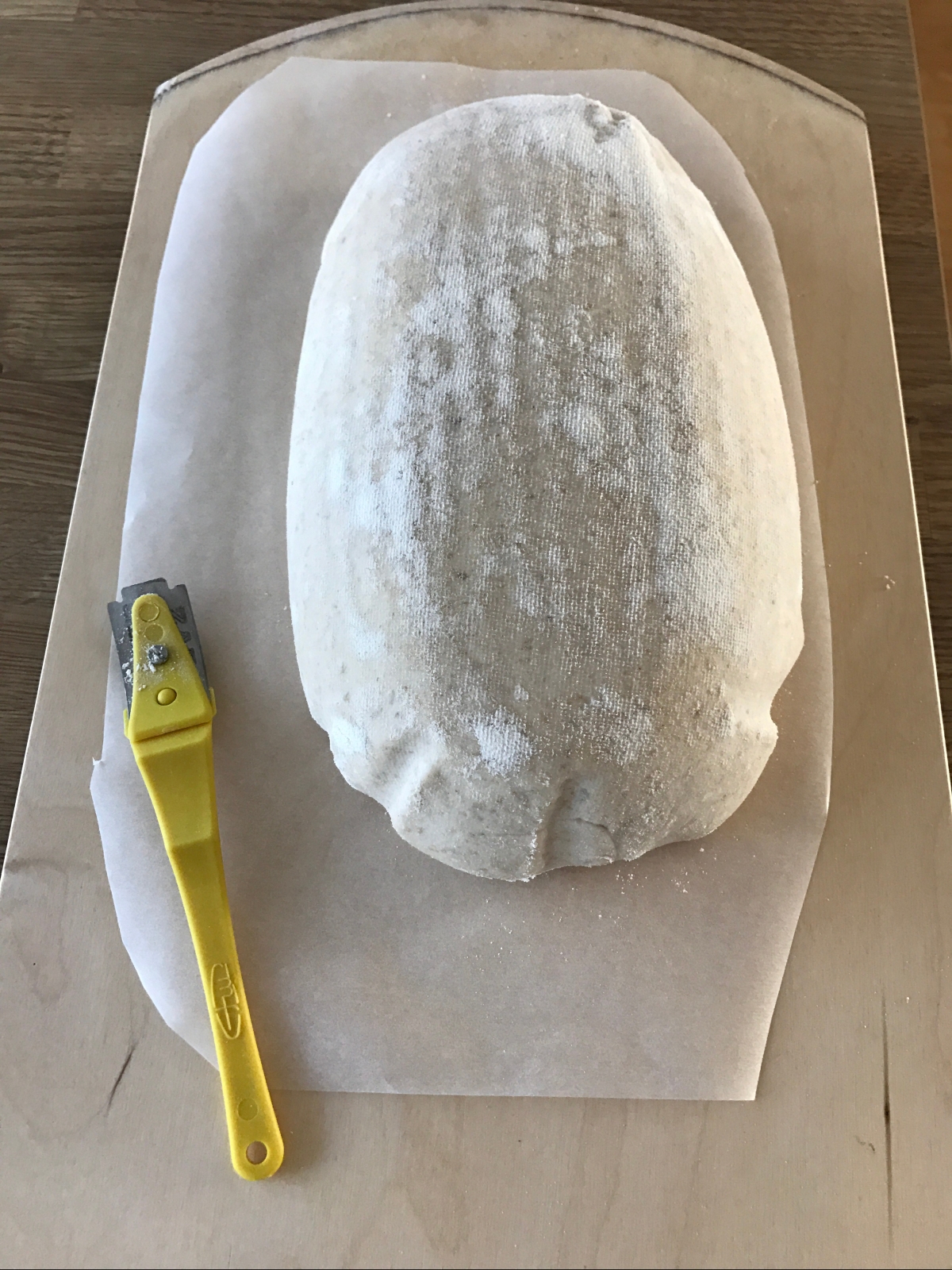
THE moment, time to put your plan into work. As you can see this dough has some flour left on it from its cold rest in a basket.
The friction (swiftness)
You want those really clean cuts right? No jagged dragged edges. The dough should not want to follow your blades direction. It should stay put and open up with clean edges.
A softer surface will more easily drag with the blade (room temp proofed dough, higher hydrated dough, closed environment damp surface proofed dough). A drier, harder surface will give you less friction and cleaner cuts. Read more in the previous part about how the state of the dough affects the friction.
Keep in mind also that the longer a stickier material is in contact with another material the more likely it’ll get stuck. Swiftness is a variable because of this. Now you don’t have to draw quicker than your own shadow to create clean cuts so take it easy still. Controlled trumps quick, find the balance here.
You also want to avoid the potential touching of the blade holder (on the lame if you have one) as well. It can cause the dragging too or create patterns in the flour on the surface that you don’t want.
By dipping the blade in fine flour or rinsing it with water (you could also spray it lightly with oil) you reduce the friction from the blade as well. I usually do the first right before making the first cuts. Make sure also to treat your blades well and by well I mean rinsing only under running water, never touch the blade and let the blade touch anything other than dough.
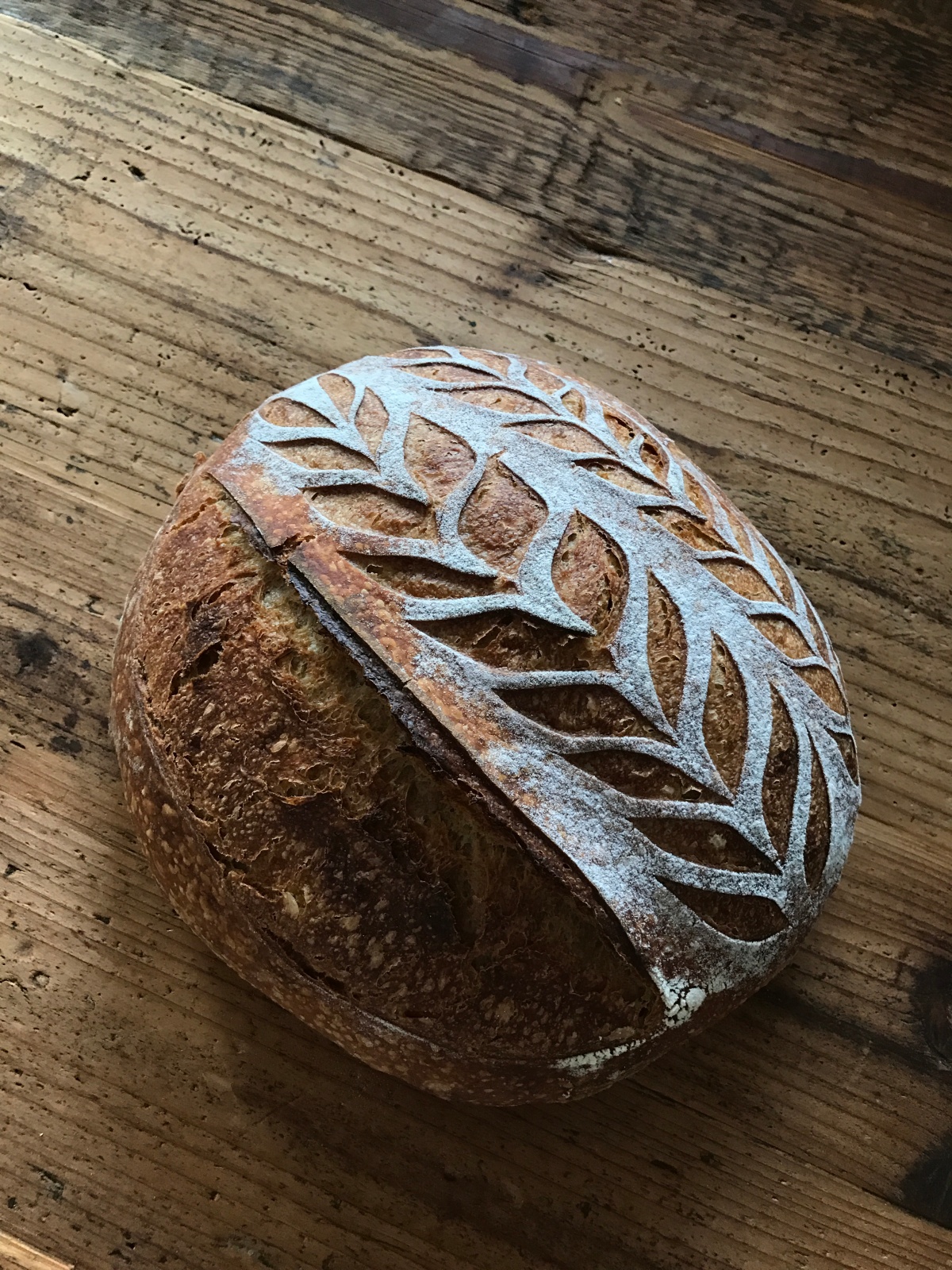
Result of above video. A rather weak dough with a higher hydration and softer surface.
The force, depth and angle
When THE moment reaches its climax you’ve made that first cut. The force, depth and angle will affect how the gasses in the dough will expand when exposed to heat, pushing the stabilizing crust up and outwards. In the first part I gave some insight in how you can adjust the cuts to the state of the dough fermentation. In this section I’m going to assume we have a good balance in proofing and strength.
I generally prefer a clean shallow cut over a deeper. If you go too deep the tension of the dough will be undermined and the risk of unnecessary spreading increases. I’d say 2-5 millimeters are enough.
If you want one side of the longer cut to rise upwards, creating ridges in the crust (or “Ears” as they are commonly called) you need to angle the cut, creating a sort of lip under the skin. A 45 degree angle is good. A curved blade helps you achieve this lip under the skin of the dough as well. If you want ears on both sides of a longer cut you don’t angle the cut at all. The expanding surface of the dough will push the lip you’ve created upwards when baked. The cleaner and more even cut you’ve made, the cleaner “ear” you’ll get (this is also very dependent on the steaming and more, I’ll come to this later). Tension in the dough surface seems to have an effect on how the ear will rise as well. Be sure to place the dough with the seam centered upwards when put in a basket and try to created an even tension without breaking the skin during the shaping phase.
Giving the blade a 45 degree angle while maintaining control, getting even depth and force is a lot harder than it looks. I’ve been absolutely certain I’ve given it an angle but in video review it shows I angle it back just as the cut is performed. The trick here is to angle the wrist and lock it, using the elbow as direction. Do not rely on your fingers angling. Your muscle memory will force you into a straighter line, such as you’ve been doing all your life when slicing something or drawing something. Lock in, hold on, trust your elbow, go for it and keep the other hand away.

The Double Ear cut. This was a medium hydrated dough that was relatively strong. You can see in the video that my wrist was angled when the vertical cuts were laid.
The added flour for contrasts
There are some choices to be made regarding contrasts before using the blade. How much flour to use if any, what type of flour and where to apply it on the loaf. Each choice will result in a different result.
I tend to use relatively little flour before putting the shaped dough in the basket for the final proofing. I never dust the cloth in the basket, only the loaf itself. Most of the flour will be absorbed in the dough and the cloth during the long retard leaving me with more choices before the bake.
I most often go with rice flour when choosing to flour the surface. It has a higher tolerance for heat and takes longer time to get burnt. I could also use regular sifted wheat if I’m looking for that rustic burnt look.
If I’m going for a straight or double cut with ears I tend to not flour at all. I think the shifting colors in the crust is a thing of beauty itself, with the blistering from the dampness in the dough reacting with the extreme heat.
If I want to add a more artistic touch to the end result I apply flour to the areas where I want a distinct effect, creating contrasts between the cuts that have opened up and the white flour. I normally use a tea dispenser filled with flour and shake it to create an even layer. If I suspect it’s unevenly spread I could also rub the surface with my hand to adjust. The video below will show you the general method.
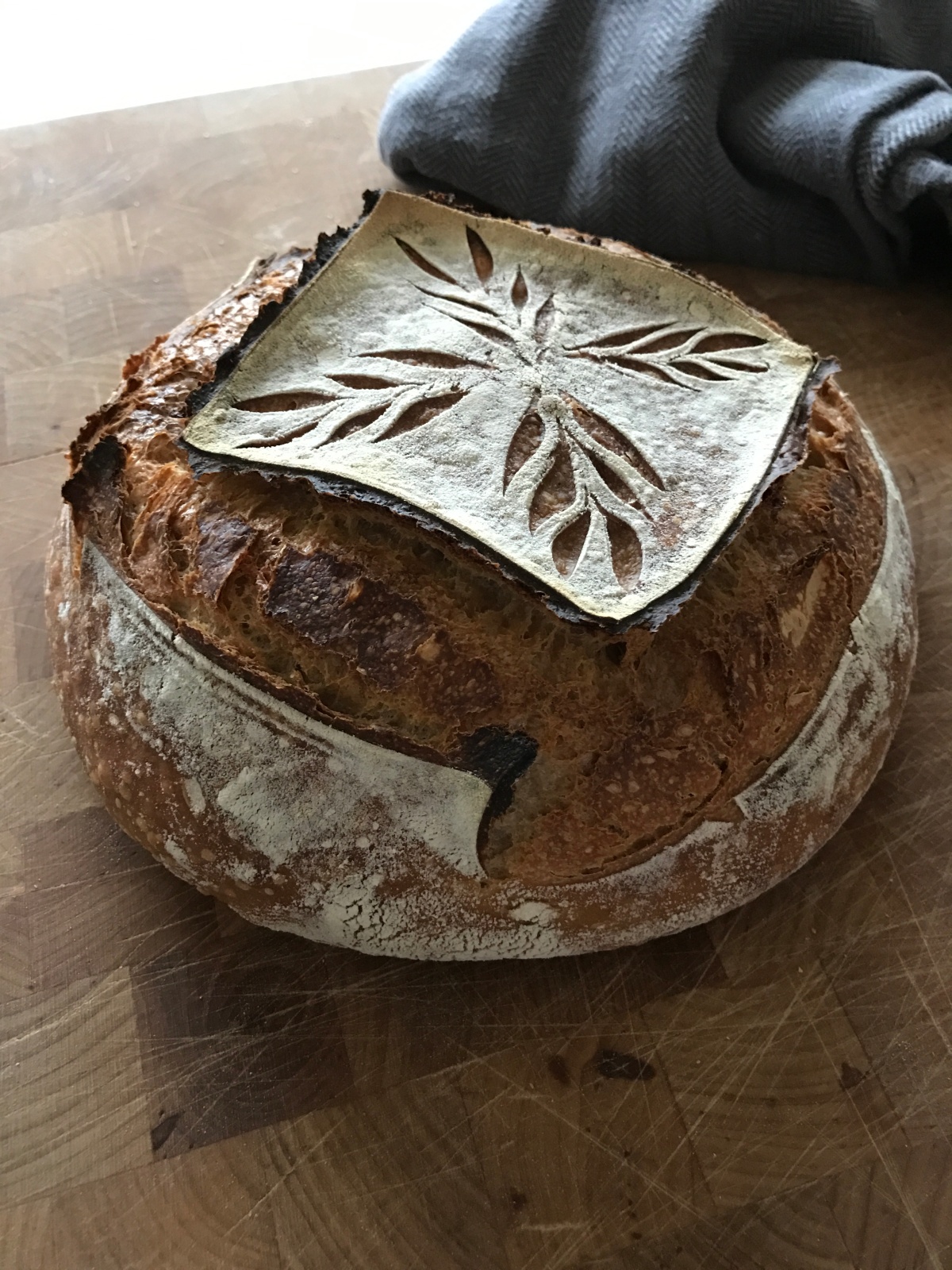
Result of above video. The contrasts in on this crust is magic! Without the flour the lines wouldn’t appear as distinct.
The heat, steam and timings during the bake
In a home environment you have some options when it comes to transfer heat effectively to the dough, making it rise to its max potential before the dough settles which happens when it reaches a certain degree. This is why it’s important to shock the dough with a higher heat, making the gases expand rapidly. You want to keep the skin of the dough flexible and damp so it wont tear during the rise or hinder the rising by settling too quick.
I’ve realized exposure to steam is vital to the development of the colors in the crust too. The longer I expose it to steam the better variations of colors in the crust I seem to get. You see, the remaining sugars in the dough will caramelize through the same Maillard reaction that happens when frying or grilling meat for example.That’s why the crust with a character is so tasty. A crust on an over proofed loaf (where less sugar is present since the yeasts have eaten most of it) will have less variations of color and won’t taste as good.
I use two different mediums to transfer heat and just as many to make hot steam take care of the skin. Either the so-called Dutch Oven or the baking stone with added steam.
The Dutch oven is a pre heated (1 hour) pot in which you’ve put the dough. By putting the lid on you will trap the steam that the dough generates when temperatures rise. The dough will take a steam bath in its own steam! It can prove difficult to transfer and score a dough in a deep pot so I’ve started using a Lodge cast iron Combo Cooker. It has a skillet that serves as a bottom and a deeper pot that serves as a lid, trapping the steam. An easy way to bake with consistent steaming results! I only use it for round loafs (Boules) since its diameter is around 24cm, limiting what oval loafs/batards I can use it for. I bake
The baking stone can be either ceramic or granite. I usually pre heat my ceramic stone (placed in the middle of the oven) for at least 2 hours at maximum temperature, otherwise the heat transfer will be too slow. I nowadays bake all my oval loafs/batards on the stone and add steam manually. I do this the following way (mostly inspired by Maurizio Leo, check out his guide for steaming here, also check his other great material):
- 10-15 minutes prior to the bake I take make two tight rolls out of kitchen cotton towels and put them in a standard size baking tin. I also insert a standard full size oven tray and the very bottom of my oven. The stone has now been pre heating for at least 1 hour and 45 minutes.
- I boil water and pour it over the tightly rolled towels slowly, making them absorb it fully. I keep pouring until the water stands about 2-3 cm from the bottom of the tin. I now insert the tin on the oven tray at the bottom of the oven. I place the tin at the center of the tray.
- DISCLAIMER – THIS STEP IS NOT VITAL AND USED AT OWN RISK: While making preparations for the scoring I plug the exhaust at the front of my oven, right above the oven door, with wet paper cloths. This will trap the steam produced in the oven better. Be advised that this will probably damage the oven in the long run. The time display of my induction stove top gets all misty (sound has stopped working too) and the doors to the cupboards around the oven takes some serious dampness during the bakes.
- I boil some more water now and prepare a long metallic ladle which I’ve bent to an almost straight angle. Right after the bread is scored I open the door (and beware of the attacking steam) and place the bread on the stone. I usually use a pizza peel with baking parchment to slide it on the stone. Now I fill the ladle with about 200ml of water and splash it on the oven tray at the bottom, creating a cloud of steam, which I try to entrap by quickly closing the door.
- I set the timer to 25 minutes and let the steaming tin sit there for the whole period. During this time I wont open the door. I bake at 250C (480F) during the first 15 minutes, lowering to 230C (445F) for the rest of the bake. Sometimes I just go with 250 all the way.
- When 25 minutes have passed I open the door, remove the tin (and the paper clogging the exhaust if used) and let the door sit open just a little while to let the dry air enter the oven. I also remove the parchment paper and spin the loaf 180 degrees, moving it to a warmer place on the stone. I bake for at least 10 more minutes, often 5-10 more depending on the color I want.
- I take the loaf out when I’m pleased with the colors and place it on a cooling rack. You should wait at least 1 hour (or actually until the inner temp is around 40C) for the crumb to settle before cutting into it.
The type of flour you use will react different during the bake. A stone ground wheat flour with high extraction (more of the original grain left) will probably give you a darker, deeper color then a roller milled wheat flour with low extraction. Different brands and breeds will have different characteristics as well, giving unique results from each harvest depending on exposure to sun and nutrition. Not to mention all the other cool stuff you can add to the flour (like purple corn and other vulgar food). It’s a never-ending palette of opportunities to your visual outcome.
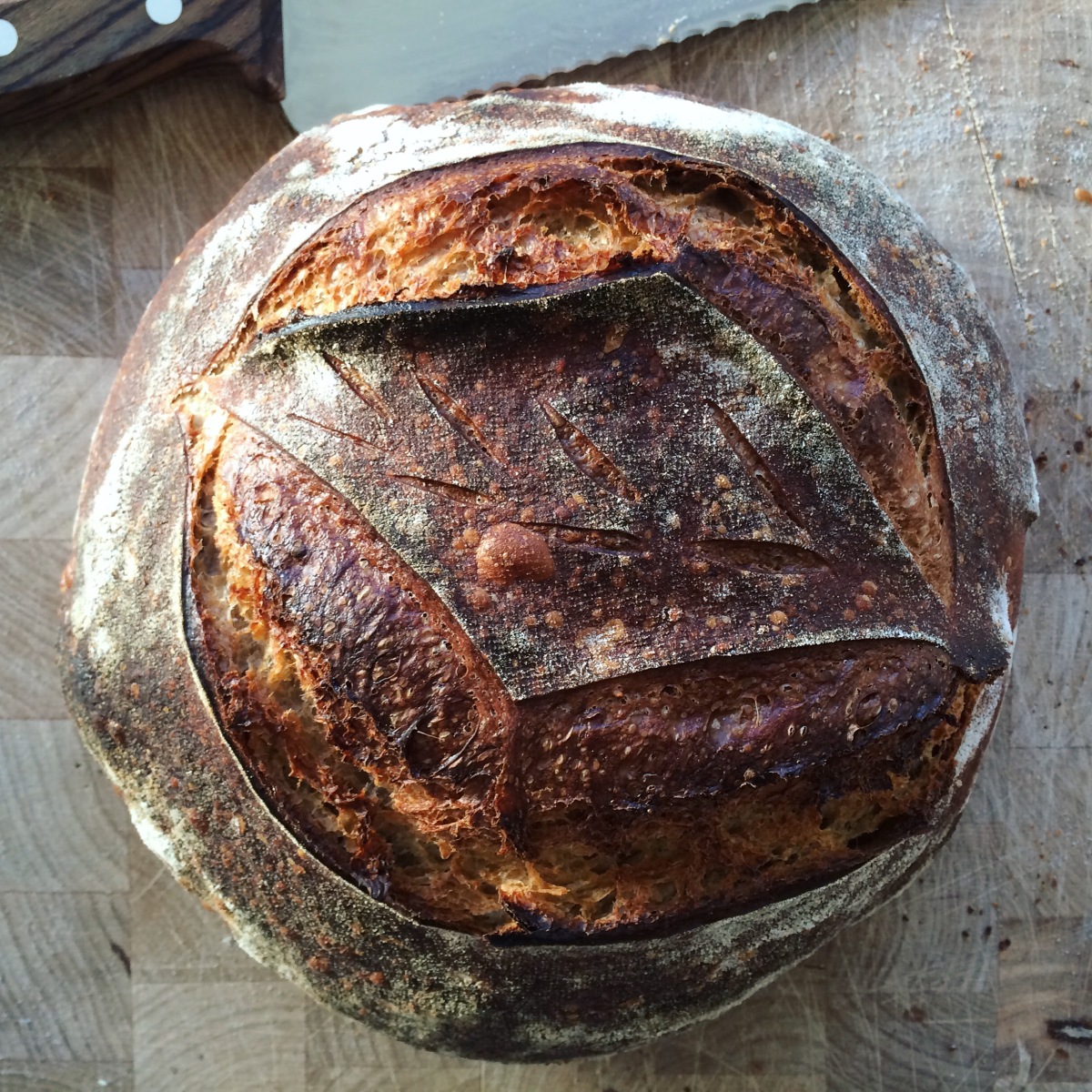
A boule made from all stone ground flour.
End note
Bake it hard if you like the darker colors. Bake it lightly if you like it lighter. Add a lot of flour if you like contrasts or add just a little or none if you want the colors of the crust to shine! Go nuts with the blade if you prefer the patterns to be the center of attention, or let the loaf reach its maximum ear height by that single and precise slash.
Give your loaf the soul you think it deserves.
It’s your choice. Best of luck!
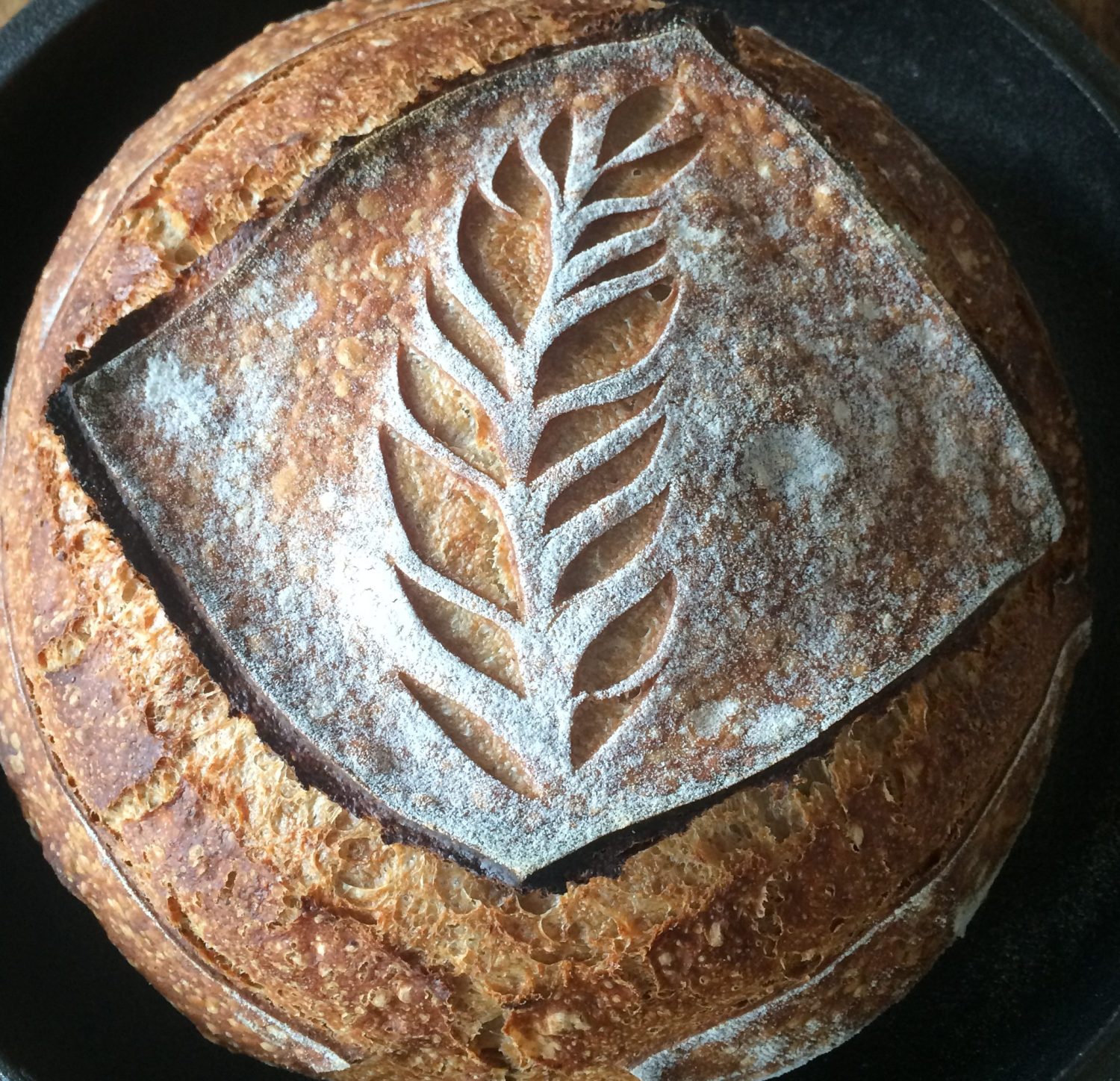
A beautiful site and lots of great info….keep it up. Thank you
LikeLike
Thank you very much Trish! Some new content are coming really soon.
LikeLike
Can’t wait…You write so beautifully and the photos are fantastic! Thank you for sharing
LikeLike
I was just wondering, is there ever such a thing as “over scoring” ? (I don’t mean the depth, but I mean the number of score cuts or the surface area that gets scored)
LikeLike
Hey Veronica! Yes, it’s absolutely a thing. Scoring should be effective in order for the surface to bloom optimally. Each stroke comes with a trade of oven spring, since tension is released from the surface . If the pattern on top is more important then the spring then it’s no real issue, the content and fermentation of the bread is still the same.
LikeLike
Namaste
It s an absolute pleasure reading your blog. Its so well defined in every stage. Thankyou so much for sharing your knowledge.
LikeLike